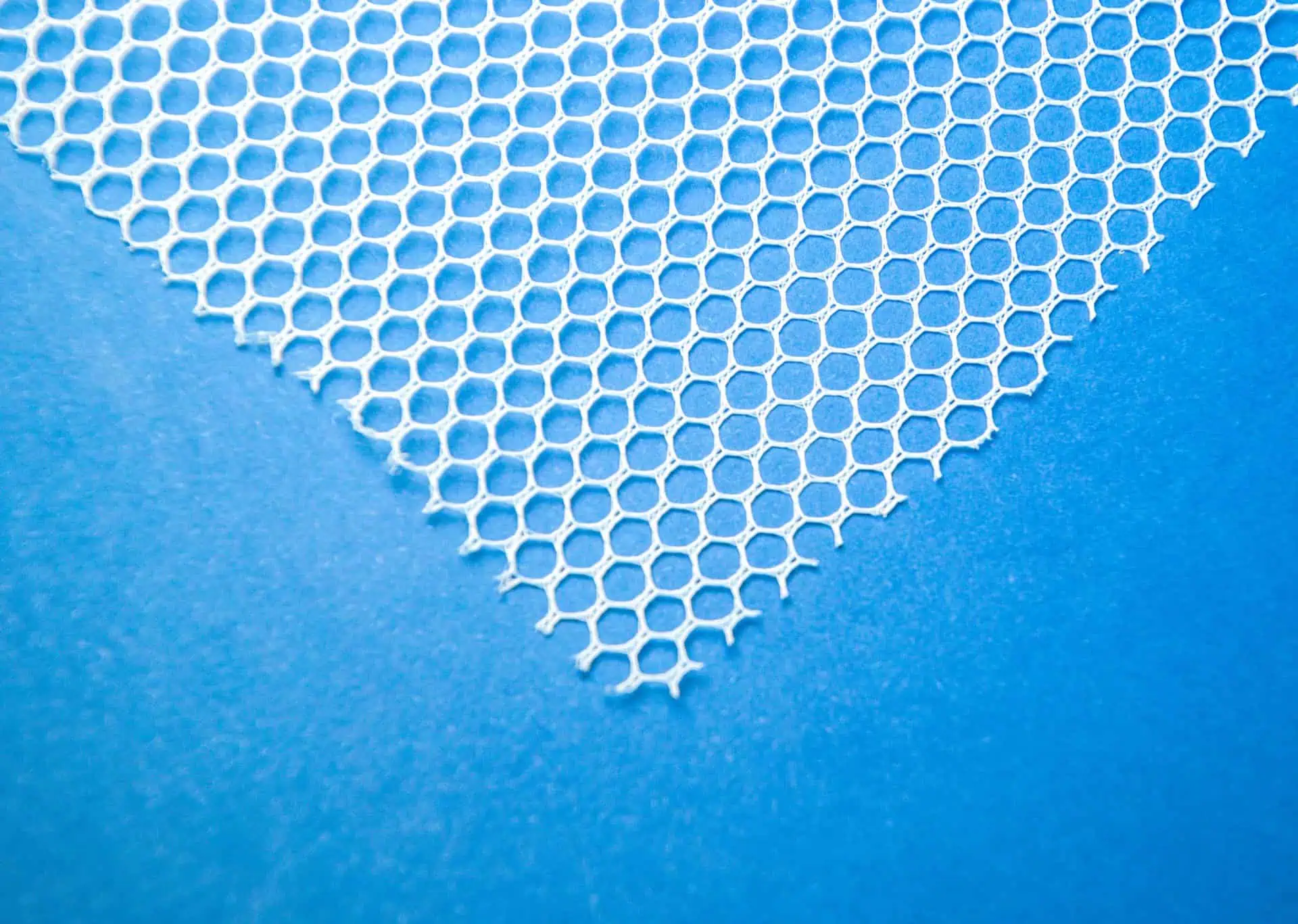Common Vaginal Mesh Problems
- Last Updated: July 14th, 2025

Attorney Jessica Paluch-Hoerman, founder of TruLaw, has over 28 years of experience as a personal injury and mass tort attorney, and previously worked as an international tax attorney at Deloitte. Jessie collaborates with attorneys nationwide — enabling her to share reliable, up-to-date legal information with our readers.
Legally Reviewed
This article has been written and reviewed for legal accuracy and clarity by the team of writers and legal experts at TruLaw and is as accurate as possible. This content should not be taken as legal advice from an attorney. If you would like to learn more about our owner and experienced injury lawyer, Jessie Paluch, you can do so here.
Fact-Checked
TruLaw does everything possible to make sure the information in this article is up to date and accurate. If you need specific legal advice about your case, contact us by using the chat on the bottom of this page. This article should not be taken as advice from an attorney.
Key takeaways:
- Vaginal mesh is a device used to treat pelvic issues in women, but it can cause serious problems like pain, infection, and organ damage.
- The FDA warned about vaginal mesh risks in 2008 and classified it as high risk in 2016 because of many reported complications.
- Negligence by manufacturers and design defects are main reasons for these problems leading many to sue the makers of this product.
Overview of Common Vaginal Mesh Problems
On this page, we’ll discuss an overview of Vaginal Mesh Problems, the current status of Vaginal Mesh Lawsuits, commonly reported causes of Vaginal Mesh problems, and much more.
Vaginal mesh problems are a significant health concern for many women who have had surgical mesh implanted to treat pelvic organ prolapse (POP) and stress urinary incontinence (SUI). Complications can range from mild discomfort to severe pain and functional impairment.
The common vaginal mesh problems reported by women who have had surgical mesh implanted to treat POP and SUI include, but are not limited to:
- Mesh erosion
- Infection
- Pain during intercourse (dyspareunia)
- Urinary problems
- Recurrent prolapse and incontinence
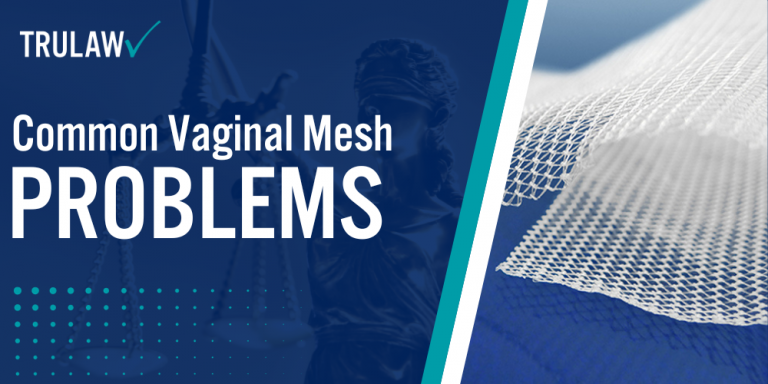
Regulatory bodies such as the Food and Drug Administration have played a significant role in the transvaginal mesh lawsuits, with many of these cases resulting in substantial settlements and verdicts.
Manufacturers of vaginal mesh have paid over $8 billion in settlements and verdicts, demonstrating the severity of the issue.
The device is a net-like structure made either from biological material or polymers. It is implanted during surgery, often through the vagina itself; this procedure is known as transvaginal mesh surgery.
Table of Contents
The Controversy Surrounding Vaginal Mesh
Vaginal mesh has been under scrutiny due to its unexpected complications and FDA alerts, sparking a heated debate about its safety and efficacy.
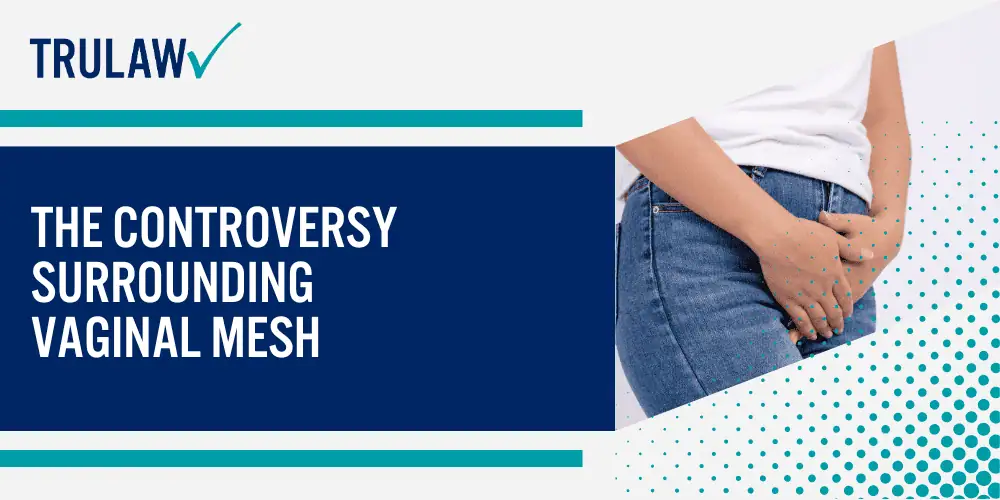
Discover more on this issue as we delve into the history of vaginal mesh use, regulatory warnings, and the rising tide of public concern.
History of Vaginal Mesh Use
Vaginal mesh found its beginnings in the 1950s as a treatment for abdominal hernias.
By the late 1990s, manufacturers introduced it into gynecology as an alternative solution to traditional surgery for conditions such as stress urinary incontinence and pelvic organ prolapse.
Initially, health professionals hailed vaginal mesh as a revolutionary product that could offer improved results with less invasive procedures.
Patients welcomed this innovative approach, promising quicker recovery times and fewer complications compared to traditional surgery methods.
However, evidence of serious problems soon began surfacing by the early 2000s.
Users reported debilitating pain and discomfort, sexual dysfunction, and injuries from eroding mesh material perforating organs and causing infections – leading to a significant increase in lawsuits during this period.
FDA Warnings and Public Awareness
The FDA first alerted the public about potential risks associated with transvaginal mesh in 2008 following numerous reports of complications.
Escalating concerns led to a second warning in 2011, announcing additional risks and stating that serious complications are not rare.
Consequently, the mesh was reclassified as a high-risk device by the FDA in 2016, sparking widespread awareness among affected patients.
Despite these warnings, surgical mesh continues to be used for treating pelvic organ prolapse and stress urinary incontinence.
This has resulted in heightened vigilance among consumers and further investigation into its safety by various regulatory bodies.
Vaginal Mesh: Severe Symptoms
Vaginal mesh complications can lead to severe symptoms including chronic pelvic pain, organ perforation, and incontinence; diving into these issues helps reveal the truly distressing nature of vaginal mesh problems.
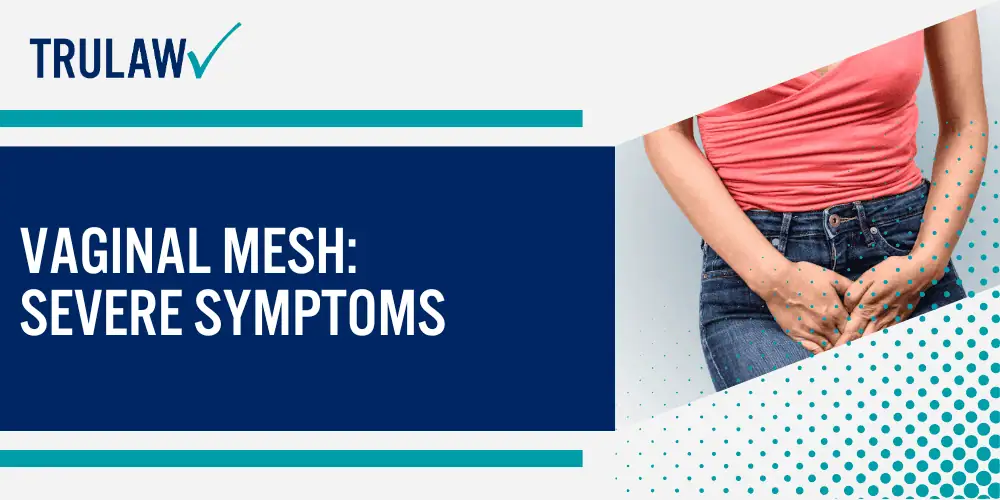
Pain, Bleeding, and Discomfort
Experiencing pain, bleeding, and discomfort can be a regular occurrence for women suffering from vaginal mesh problems.
The placement of the transvaginal mesh during pelvic organ prolapse repair might bring relief initially but sets the stage for chronic pelvic pain with time.
Daily routines may turn into laborious tasks as persistent discomfort becomes a constant reminder of the surgical mesh.
Spotting or vaginal bleeding signifies complications that need immediate attention.
Painful sexual intercourse, also known as dyspareunia, predominately occurs due to exposed mesh or erosion in the vaginal wall.
Frequently enduring such virulent conditions only adds stress to their physical health but also affects their mental well-being over time.
Organ Perforation
Organ perforation is a severe vaginal mesh problem with far-reaching implications for the patient’s health.
Transvaginal mesh, often used to treat conditions like pelvic organ prolapse and stress urinary incontinence, has unfortunately been associated with this serious complication.
The synthetic mesh can pierce or perforate organs such as the bladder or bowels during surgery or even years afterwards.
Such complications may lead to increased pain, infection risks and further surgical interventions, significantly impacting the patient’s quality of life.
It’s important to note that the risk of organ perforation isn’t just immediate post-surgery; it can also manifest much later making regular follow-ups crucial after undergoing procedures involving transvaginal mesh.
Incontinence and Urinary Problems
Experiencing incontinence and urinary problems is a common complication following transvaginal mesh surgery.
The implanted surgical mesh, intended to provide support for weakened pelvic organs, can sometimes lead to unwanted side effects such as stress urinary incontinence or voiding dysfunction.
Various factors contribute to these issues; however, one key issue relates to the potential erosion of synthetic mesh into the bladder, causing irritation and subsequent urinary problems including a frequent urge to urinate and painful urination.
In more severe cases, women may face complete loss of bladder control or recurrent urinary tract infections.
These complications impact daily life significantly requiring further treatment or potentially another surgery for mesh removal, adding physical discomfort and mental strain on patients already dealing with pelvic organ prolapse.
Erosion of Vaginal Tissue
Vaginal mesh erosion represents a significant complication in pelvic floor reconstructive surgery.
This problematic occurrence involves the surgical mesh material breaking through the vaginal tissue, leading to an array of distressing symptoms.
Women experiencing this issue may report feelings of tightness, pain during sexual activity, unusual bleeding or discharge, and urinary complications.
In multiple cases, infections related to the mesh have surfaced as a direct result of this erosion process.
Addressing these complications often necessitates further corrective procedures or even complete removal of the mesh device to alleviate discomfort and restore normal function.
Protrusion from the Vagina
Experiencing a sensation of something bulging or protruding from the vagina can be quite unsettling.
This is often a sign of vaginal mesh complications where part of the mesh becomes exposed or pushes through the tissue lining, leading to discomfort and possible infections.
Vaginal mesh extrusion can bring about this uncomfortable feeling during daily activities or even sexual intercourse.
Individuals dealing with this symptom may also notice other issues related to urinary problems and pelvic pain.
In some cases, vaginal mesh erosion leads to parts of it being visibly present in the vagina.
The presence of infection around these areas could worsen symptoms and increase feelings of protrusion in sufferers.
Coping with such conditions can affect one’s overall quality of life significantly, disrupting day-to-day activities while increasing mental stress due to ongoing discomfort.
Causes of Vaginal Mesh Problems
Delving into the causes of vaginal mesh complications, we’ll discuss how factors like manufacturing negligence, design flaws, and breach of warranties play significant roles in provoking such distressing outcomes.
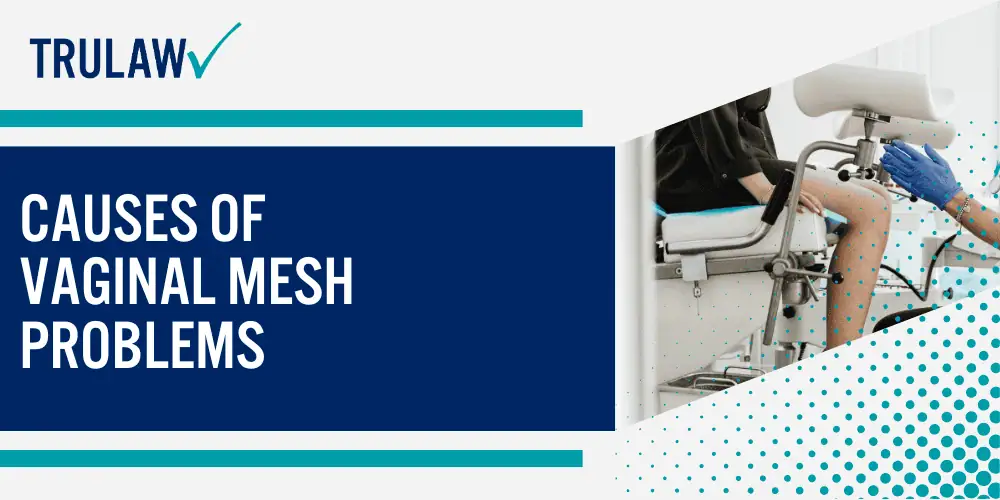
Negligence of Manufacturers
Manufacturers of vaginal mesh implants often face accusations of negligence in transvaginal mesh lawsuits.
These allegations largely revolve around their inability to ensure the safety and effectiveness of these devices.
An integral part of these lawsuits is the claim that manufacturers have failed to adequately warn doctors and patients about potential risks, leading to serious complications such as pelvic pain, sexual discomfort, urinary problems, bleeding, infection, and even occurrences like mesh extrusion where the device protrudes through the skin or organ.
Recalls prompted by high rates of adverse events further substantiate claims concerning manufacturer negligence.
In light of this, it becomes clear how important accountability in manufacturing practices truly is for ensuring patient safety.
Design and Manufacturing Defects
Design and manufacturing defects are significant causes of vaginal mesh problems.
Faulty design flaws may lead to an improperly fitting mesh that fails to support the pelvic organs as intended, causing severe complications such as erosion of vaginal tissue and organ perforation.
Manufacturing errors may result in impurities or weaknesses in the surgical mesh material, increasing the risk for serious health issues like chronic pelvic pain and urinary problems.
Subpar quality control during production can also contribute to these defects, exacerbating already prevalent complications experienced by patients post-surgery.
It is crucial that manufacturers adhere strictly to standards set by regulatory bodies like the Food and Drug Administration (FDA) to ensure patient safety and well-being throughout all stages of transvaginal mesh procedures.
Breach of Warranties
Manufacturers of vaginal mesh devices often promote their products with several warranties.
However, a significant number of these surgical tools have presented serious complications post-surgery, leading to allegations of breach of warranties.
In such cases, patients claim that the companies did not adhere to the promise made regarding the safety and efficacy of these medical appliances.
This legal action falls under product liability law where consumers are protected against defective products that can cause injury or harm.
These accusations put companies like Boston Scientific, Johnson & Johnson, and C.R Bard among others in hot water for violating warranty laws set to safeguard public health.
By breaching express or implied guarantees about a product’s nature or quality, manufacturers open themselves up to litigation from affected individuals seeking compensation for damages sustained due to this violation.
Current Status of Vaginal Mesh Lawsuits
Let’s explore the current status of vaginal mesh lawsuits, including multidistrict litigation, bellwether trials, and ongoing settlements and litigations.
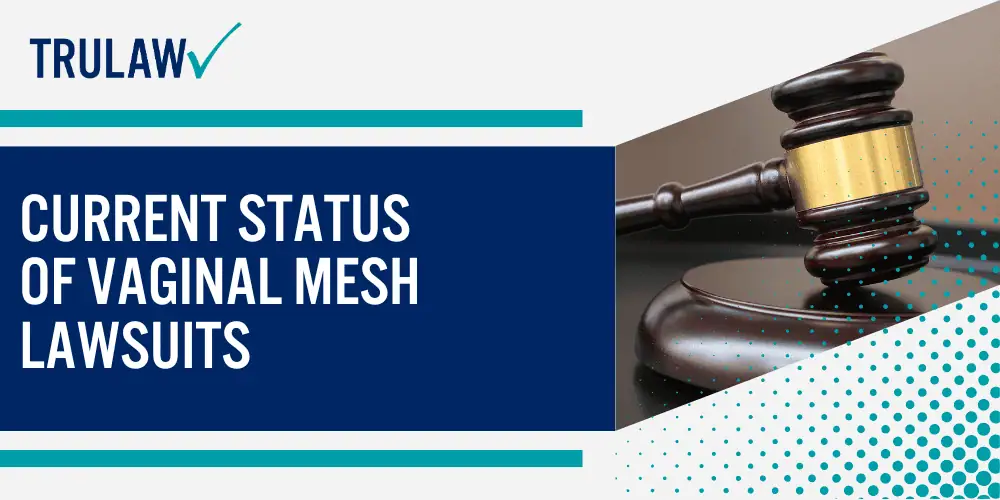
MDL Class Action Lawsuits
Multidistrict litigation (MDL) class action lawsuits have played a pivotal role in the vaginal mesh controversy.
Women across different states penned their individual suits, all alleging similar harms caused by these devices.
Uniting these cases expedites proceedings and eliminates inconsistent pretrial rulings.
Notably, one of the most significant MDLs for transvaginal mesh lawsuits has been officially closed after many years of battles in courtrooms.
Vaginal mesh manufacturers such as Johnson & Johnson and Ethicon have faced thousands of these legal claims, leading to settlements exceeding $8 billion overall.
Despite this closure, other individual cases against these corporations continue at state levels, striving for justice for women impacted by vaginal mesh complications.
Bellwether Trials
Bellwether trials play a crucial part in managing the overwhelming number of vaginal mesh lawsuits.
These initial cases serve as indicators, revealing legal trends and possible outcomes.
Through them, manufacturers gain insights into how juries respond to presented evidence, setting a precedent for future litigation.
Some prominent transvaginal mesh makers have already settled extensive legal claims exceeding $8 billion through this process.
However, it is important to note that each case’s settlement terms were not usually disclosed to the public.
Despite most lawsuits reaching settlements amounting roughly to $8 billion in personal injury settlements over the past decade, there are still active litigations today due significantly to bellwether trials.
Settlements and Continued Litigation
Mesh manufacturers have settled thousands of lawsuits, compensating victims with over $8 billion collectively.
These settlements involved numerous cases where vaginal mesh complications caused severe harm to women.
High-profile companies like Johnson & Johnson faced hefty penalties for their negligence in product safety and disclosure of risks.
Approximately 5% of cases remain unresolved, indicating ongoing litigation for pelvic mesh complications.
Numerous victims continue to challenge the legal system, seeking justice for their suffering due to surgical mesh complications.
While there are victories in courtrooms and settlements reached, this section of transvaginal mesh litigation history is far from closed.
Understanding the FDA Actions and Regulatory Changes
The FDA’s concerns about the usage of surgical mesh for treating pelvic organ prolapse have sparked a wave of vaginal mesh lawsuits.

Impact on vaginal mesh use and lawsuits
Complications from this device have pushed many victims to seek justice and compensation in court.
Manufacturers face accusations of negligence, design defects, and breach of warranty violations in these cases.
The complaints center around the significant physical discomfort that patients experience, including pain, bleeding, and urinary problems – all common issues attributable to vaginal mesh use.
This has led to numerous Transvaginal Mesh Class Action Lawsuits across the U.S., making an indelible impact on both patient safety standards within the medical community and manufacturers’ legal obligations towards their consumers.
Potential Settlement Amounts of Vaginal Mesh Lawsuits
In this section, we delve into the financial aspect of vaginal mesh lawsuits, highlighting prominent settlement figures from recent cases and shedding light on the variables that may influence the magnitude of these compensation amounts.
Examples of recent settlements
Johnson & Johnson, a major mesh manufacturer, agreed in 2019 to pay out $117 million to resolve claims from 41 states and the District of Columbia over deceptive marketing of their pelvic mesh products.
In another substantial settlement that same year, a woman in California won $344 million from Johnson & Johnson as part of her lawsuit regarding malfunctioning vaginal meshes.
One Boston Scientific case ended with a record-setting verdict – an eye-watering sum of nearly $100 million awarded to the plaintiff in May 2015.
She claimed that she was injured by two products: the Pinnacle and Advantage Fit kits.
This marked one of the highest jury awards so far related to vaginal mesh complications.
In February 2020, C.R Bard Inc. settled around 3,000 cases for about $60 million.
The list goes on indicating how these lawsuits continue generating high payout settlements for those who suffer severe complications due to faulty vaginal mesh implants.
Factors that may affect Transvaginal Mesh Lawsuit settlement amounts
Several elements come into play while determining settlement amounts in vaginal mesh lawsuits.
Primarily, the degree of physical injury suffered due to a faulty mesh significantly impacts the settlement amount.
For instance, complications such as organ perforation or severe discomfort often lead to higher compensation figures.
The age and health condition of the plaintiff also can be influential factors.
Younger plaintiffs with more serious injuries might receive larger settlements than older ones with similar conditions.
Prior lawsuit outcomes provide another critical perspective; recent cases suggest that successful settlements could range from $150,000 to $450,000 in 2023 depending on the severity of harm caused by mesh complications.
Potential Settlement Amounts of Vaginal Mesh Lawsuits
Johnson & Johnson, a major mesh manufacturer, agreed in 2019 to pay out $117 million to resolve claims from dozens of states and the District of Columbia over deceptive marketing of their pelvic mesh products.
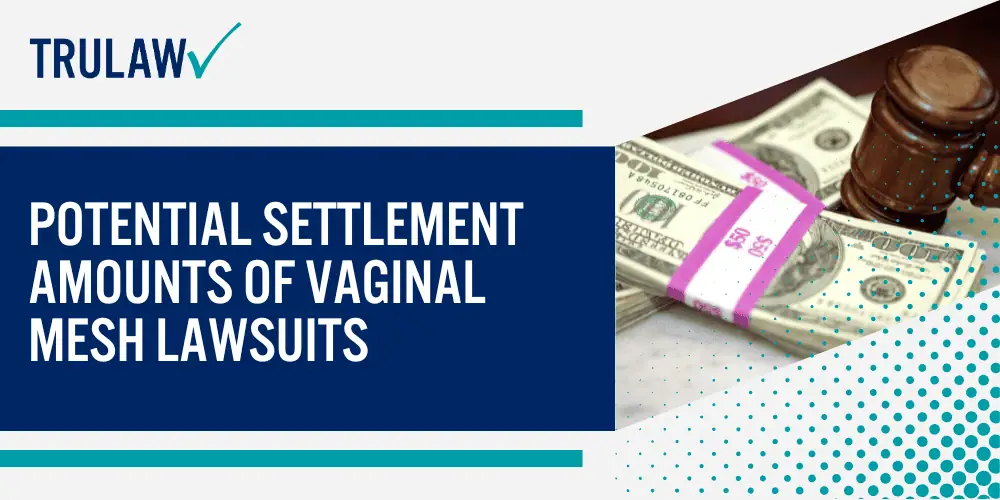
Examples of Recent Vaginal Mesh Settlements
In another substantial settlement that same year, a woman in California won $344 million from Johnson & Johnson as part of her lawsuit regarding malfunctioning vaginal meshes.
One Boston Scientific case ended with a record-setting verdict – an eye-watering sum of nearly $100 million awarded to the plaintiff in May 2015.
She claimed that she was injured by two products: the Pinnacle and Advantage Fit kits.
This marked one of the highest jury awards so far related to vaginal mesh complications.
In February 2020, C.R Bard Inc. settled around 3,000 cases for about $60 million.
The list goes on indicating how these lawsuits continue generating high payout settlements for those who suffer severe complications due to faulty vaginal mesh implants.
Who Can File a Vaginal Mesh Lawsuit?
Any individual who has suffered from complications due to vaginal mesh, such as chronic pelvic pain, urinary problems, or mesh erosion, may be eligible to file a lawsuit.
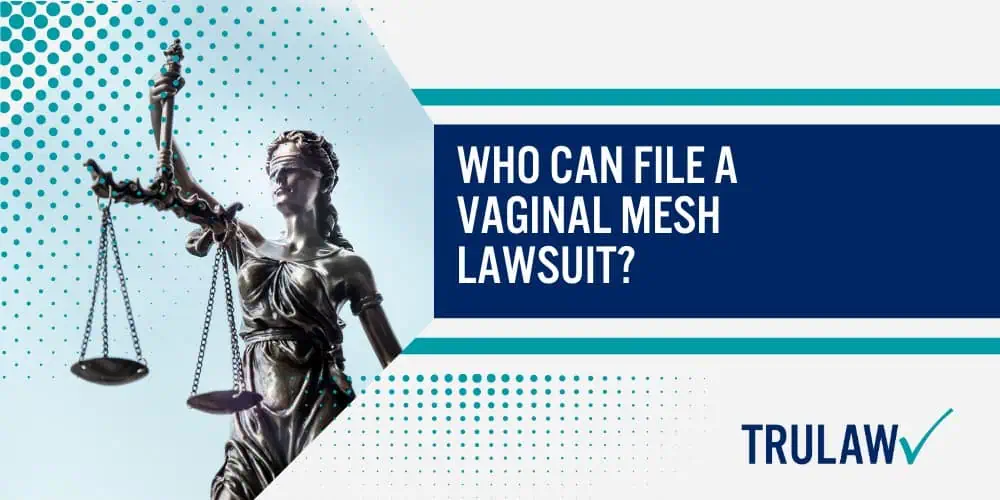
If you have undergone surgery for pelvic organ prolapse or stress urinary incontinence involving transvaginal mesh devices and experienced severe after-effects, it’s essential to consider legal recourse.
Qualifications of the Vaginal Mesh Lawsuit
You may qualify to join a vaginal mesh lawsuit if you have suffered severe complications after undergoing pelvic organ prolapse surgery with this medical device.
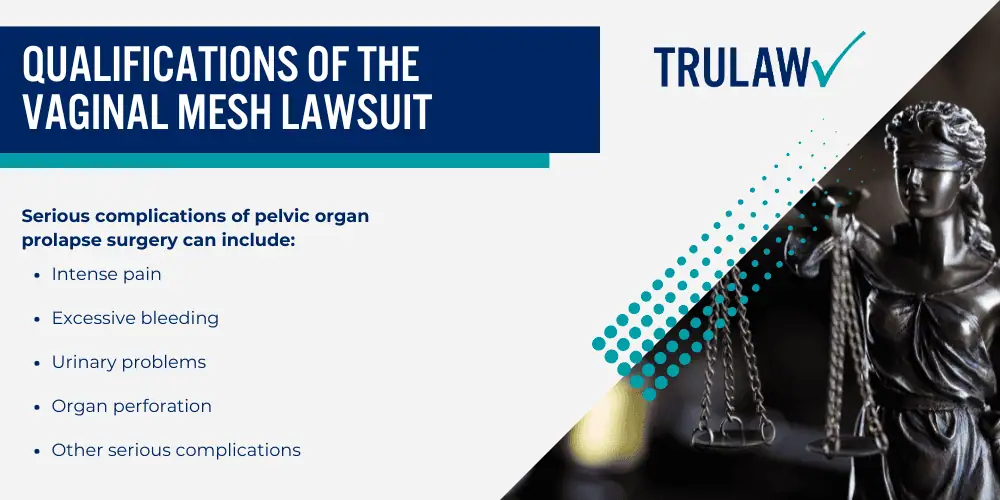
Serious complications of pelvic organ prolapse surgery can include:
- Intense pain
- Excessive bleeding
- Urinary problems
- Organ perforation
- Other serious complications
Also, if the negligence of manufacturers or breaches of warranties are evident in your case, it may also strengthen your eligibility to file a lawsuit.
Thousands of women who experienced such agonizing outcomes have already taken legal action against responsible parties for their tribulations.
Steps of the Vaginal Mesh Lawsuit
Filing a lawsuit for vaginal mesh complications requires thoughtful preparation and deliberate action.
The first step is to secure all medical records, documentation of symptoms, and evidence of medical expenses related to the mesh implant.
Such documents provide crucial support in proving that you have faced serious health issues due to the vaginal mesh.
Next, finding an experienced attorney who specializes in vaginal mesh lawsuits becomes vital.
They will guide through the legal system and help build a strong case against the manufacturers.
Upon finding your lawyer, they will evaluate your case’s merit based on gathered information and determine if pursuing litigation makes sense both legally and financially.
The process does not end here; preparing for possible trial or settlement discussions follows suit once a court accepts the lawsuit.
Be ready for direct examinations, cross-examinations, and statements from expert witnesses – these are integral parts of courtroom proceedings that demand attention.
Despite seeming overwhelming at times, filing a lawsuit can offer justice for those suffering from adverse effects tied to their transvaginal mesh implants.
You could potentially receive compensation acknowledging the pain endured as well as cover any associated financial burdens incurred while addressing these unwanted complications.
Seeking Legal Help for Vaginal Mesh Complications
Navigating the maze of transvaginal mesh lawsuits requires a seasoned attorney who specializes in medical device litigation.

Choosing a skilled attorney
An experienced lawyer at TruLaw will provide guidance through each stage of the lawsuit process, while diligently working towards recovering compensation for your medical bills and pain caused by these harmful implants.
For instance, Johnson & Johnson, a major manufacturer involved in these lawsuits, was previously held accountable due to such expert legal representation.
Exploring your legal options
Legal options for sufferers of vaginal mesh complications are varied.
You can choose to file an individual lawsuit or join a class action, depending on your circumstances and preference.
TruLaw: Seeking Justice
To conclude, it is crucial for victims of vaginal mesh complications to take a stand against these alarming issues, and relentlessly seek rightful justice and financial compensation for their suffering and damages.
This fight not only brings personal relief but contributes vastly towards raising global awareness about the dire consequences of using vaginal mesh implants, thereby prompting urgent changes in medical practices worldwide.
Compensation for Damages
Women affected by vaginal mesh complications have the right to seek justice.
Taking legal action can help achieve this goal, as it not only helps in receiving compensation for medical expenses, loss of wages, pain, and suffering but also holds responsible parties accountable for their negligence or product defects.
Mesh companies that disregarded patient safety by releasing faulty products are now facing substantial lawsuit settlements exceeding $8 billion in some cases.
Transvaginal Mesh Lawsuit Frequently Asked Questions
-
One of the most common problems associated with vaginal mesh is the mesh eroding through the vaginal wall.
The symptoms of mesh erosion may include:
- Discomfort and pain, often requiring surgical intervention
- Infections and abnormal vaginal discharge
- Vaginal bleeding and scarring
-
Pelvic mesh is a medical device that is sometimes used in combination with a hysterectomy, although it is not a routine part of the procedure.
It is typically used to treat pelvic organ prolapse (POP) and stress urinary incontinence (SUI), conditions that can occur after a hysterectomy.
It is most commonly used to treat pelvic organ prolapse (POP) and stress urinary incontinence (SUI), which may occur after a hysterectomy. The mesh is implanted surgically to provide additional support to the pelvic organs and tissues.
If you have any concerns or questions about the use of pelvic mesh, it is important to discuss them with your healthcare provider.
-
Surgical mesh complications are issues that arise from the use of surgical mesh, a reinforcement for tissue or bone, often used in hernia repair or urological problems.
When considering the complications associated with surgical mesh, it’s crucial to note:
- Erosion of the tissue covering the surgical mesh is a common complication, leading to the mesh poking through the skin.
- The mesh can also cause infections or contract, causing the tissue around it to tighten, which increases strictures.
- These complications can lead to severe pain, infection, and other health issues, and in some cases, may require additional surgery to correct.
-
Removing a problematic vaginal mesh is indeed possible, and the complexity of the procedure depends on the amount of mesh to be removed.
Here are key takeaways regarding the removal of a problematic vaginal mesh:
- Removal of small amounts of vaginal mesh can often be done as an outpatient procedure.
- Removal of all or large portions of the mesh is more complex and needs to be performed in a hospital.
- After the procedure, recovery time and aftercare measures need to be adhered to.
-
Based on a study, transvaginal mesh was found to be slightly more effective than native tissue repair with an 83.6% composite success rate for transvaginal mesh compared to 72.7% for native tissue repair.
However, both methods were effective in treating pelvic organ prolapse (POP), with similar rates of success and complications.

Managing Attorney & Owner
With over 25 years of legal experience, Jessica Paluch-Hoerman is an Illinois lawyer, a CPA, and a mother of three. She spent the first decade of her career working as an international tax attorney at Deloitte.
In 2009, Jessie co-founded her own law firm with her husband – which has scaled to over 30 employees since its conception.
In 2016, Jessie founded TruLaw, which allows her to collaborate with attorneys and legal experts across the United States on a daily basis. This hypervaluable network of experts is what enables her to share the most reliable, accurate, and up-to-date legal information with our readers!
Additional Transvaginal Mesh Lawsuit resources on our website:
Here, at TruLaw, we’re committed to helping victims get the justice they deserve.
Alongside our partner law firms, we have successfully collected over $3 Billion in verdicts and settlements on behalf of injured individuals.
Would you like our help?
At TruLaw, we fiercely combat corporations that endanger individuals’ well-being. If you’ve suffered injuries and believe these well-funded entities should be held accountable, we’re here for you.
With TruLaw, you gain access to successful and seasoned lawyers who maximize your chances of success. Our lawyers invest in you—they do not receive a dime until your lawsuit reaches a successful resolution!
AFFF Lawsuit claims are being filed against manufacturers of aqueous film-forming foam (AFFF), commonly used in firefighting.
Claims allege that companies such as 3M, DuPont, and Tyco Fire Products failed to adequately warn users about the potential dangers of AFFF exposure — including increased risks of various cancers and diseases.
Depo Provera Lawsuit claims are being filed by individuals who allege they developed meningioma (a type of brain tumor) after receiving Depo-Provera birth control injections.
A 2024 study found that women using Depo-Provera for at least 1 year are five times more likely to develop meningioma brain tumors compared to those not using the drug.
Suboxone Tooth Decay Lawsuit claims are being filed against Indivior, the manufacturer of Suboxone, a medication used to treat opioid addiction.
Claims allege that Indivior failed to adequately warn users about the potential dangers of severe tooth decay and dental injuries associated with Suboxone’s sublingual film version.
Social Media Harm Lawsuits are being filed against social media companies for allegedly causing mental health issues in children and teens.
Claims allege that companies like Meta, Google, ByteDance, and Snap designed addictive platforms that led to anxiety, depression, and other mental health issues without adequately warning users or parents.
Transvaginal Mesh Lawsuits are being filed against manufacturers of transvaginal mesh products used to treat pelvic organ prolapse (POP) and stress urinary incontinence (SUI).
Claims allege that companies like Ethicon, C.R. Bard, and Boston Scientific failed to adequately warn about potential dangers — including erosion, pain, and infection.
Bair Hugger Warming Blanket Lawsuits involve claims against 3M — alleging their surgical warming blankets caused severe infections and complications (particularly in hip and knee replacement surgeries).
Plaintiffs claim 3M failed to warn about potential risks — despite knowing about increased risk of deep joint infections since 2011.
Baby Formula NEC Lawsuit claims are being filed against manufacturers of cow’s milk-based baby formula products.
Claims allege that companies like Abbott Laboratories (Similac) and Mead Johnson & Company (Enfamil) failed to warn about the increased risk of necrotizing enterocolitis (NEC) in premature infants.
Here, at TruLaw, we’re committed to helping victims get the justice they deserve.
Alongside our partner law firms, we have successfully collected over $3 Billion in verdicts and settlements on behalf of injured individuals.
Would you like our help?
